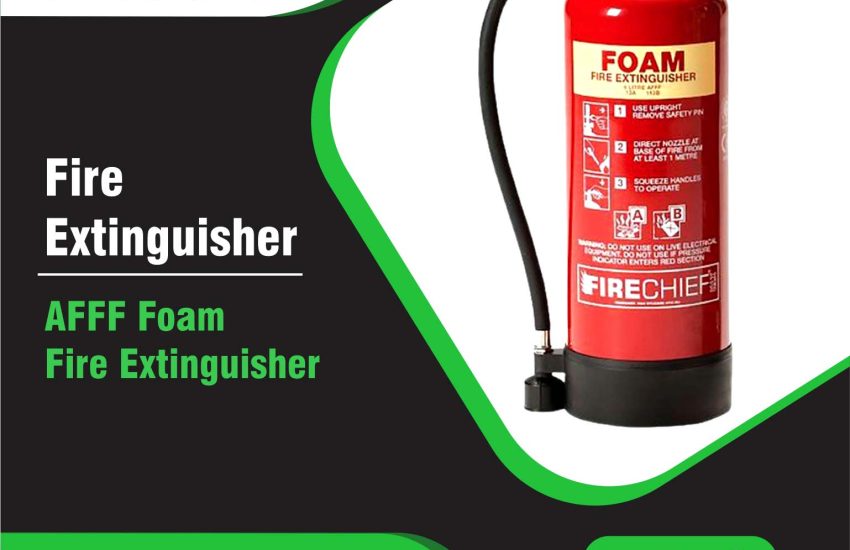AFFF Foam Fire Extinguisher and Applications An AFFF foam fire extinguisher is a powerful and efficient tool designed to combat Class A and Class B fires. AFFF, or Aqueous Film-Forming Foam, forms a barrier that smothers flames and prevents the release of dangerous vapors from flammable liquids. This article covers the full specifications, features, and applications of AFFF foam fire extinguishers to help you understand how they work and where they are best used.
What is an AFFF Foam ?
An AFFF foam fire extinguisher uses a water-based foam solution to extinguish fires. It is especially effective on Class A fires (solid combustibles like paper, wood, and textiles) and Class B fires (flammable liquids such as gasoline, oils, and solvents). The foam creates a layer that suffocates the fire, cutting off its oxygen supply and preventing it from reigniting.
AFFF Foam Fire Extinguisher Specifications:
Let’s look at the key specifications of AFFF foam fire extinguishers:
1. Capacity
AFFF foam extinguishers come in a variety of sizes, ranging from 2 kg to 50 kg.
- Smaller units (2-6 kg) are ideal for residential or small commercial settings.
- Larger models (10 kg and above) are suited for high-risk or industrial environments.
2. Discharge Time
The discharge time typically ranges from 10 to 25 seconds, depending on the extinguisher size.
- A 6 kg AFFF extinguisher discharges in about 15-20 seconds, providing enough time to control or extinguish the fire.
3. Discharge Range
AFFF extinguishers have a discharge range of 2-6 meters (6-20 feet).
Larger units offer a greater discharge range, allowing for more effective coverage in bigger spaces.
4. Operating Pressure
Operating pressure for an AFFF foam extinguisher is typically between 10 to 16 bar at 15°C, ensuring the foam is dispensed effectively under pressure.
5. Temperature Range
AFFF foam fire extinguishers are effective in temperatures ranging from -20°C to 60°C.
This wide range ensures performance in both cold and hot environments.
6. Material
AFFF extinguishers are generally made of high-quality steel, which is corrosion-resistant and durable.
- The nozzle and hose are made from materials like aluminum or brass to withstand high pressure.
7. Fire Class
- Class A Fires: Fires involving solid combustibles (e.g., wood, paper).
- Class B Fires: Fires caused by flammable liquids (e.g., oil, gasoline).
AFFF foam extinguishers are highly effective on both Class A and Class B fires.
8. Maintenance and Service
To ensure proper functioning, AFFF foam extinguishers should be inspected every 6 months to 1 year.
Inspections focus on checking the pressure gauge, ensuring no leaks, and verifying the nozzle is clear.
Features of AFFF Foam Fire Extinguishers:
- Effective on Flammable Liquids: AFFF foam forms a film layer on flammable liquids, preventing vapors from escaping and smothering the fire.
- Fast and Efficient: The foam is quick-acting, suppressing flames rapidly, especially in fires involving oils and fuels.
- Minimal Residue: Unlike powder-based extinguishers, AFFF foam leaves minimal residue, making cleanup easier.
This is ideal for environments with sensitive electronics or equipment. - Versatile: AFFF foam extinguishers work on both solid combustibles (Class A) and flammable liquids (Class B).
They are perfect for use in kitchens, offices, factories, and industrial settings. - Non-Conductive: AFFF foam is non-conductive, making it safe for use on electrical fires when power is turned off.
Advantages of AFFF Foam:
- Dual-Class Fire Protection: AFFF extinguishers protect against both Class A and Class B fires, making them versatile for many fire safety needs.
- Excellent for Flammable Liquids: AFFF is especially effective for fires involving flammable liquids like gasoline, solvents, and oils.
The foam seals the surface, cutting off oxygen and stopping re-ignition. - Clean and Safe: Unlike dry powder extinguishers, AFFF foam leaves little to no residue, reducing the risk of damage to electronics and machinery.
- Fast Action: The foam not only extinguishes the fire but also prevents it from spreading, allowing for faster suppression.
- Environmentally Friendly: AFFF foam is generally more environmentally friendly than other fire suppression agents, as it contains fewer toxic chemicals.
Applications of AFFF Foam:
- Commercial Kitchens: AFFF foam extinguishers are ideal for kitchen fires, which often involve cooking oils and fats.
They can also handle fires caused by ordinary combustibles like paper towels. - Industrial Settings: Factories, warehouses, and production facilities often store flammable liquids, making AFFF foam extinguishers essential for fire safety.
- Automotive and Petroleum: In auto repair shops, oil refineries, and petroleum storage facilities, AFFF foam extinguishers handle fires caused by fuels and flammable chemicals.
- Maritime and Aviation: AFFF foam is used in ships, aircraft, and fuel storage areas to suppress fires from flammable liquids and gases.
How to Use an AFFF Foam Fire Extinguisher:
- Pull the Pin: Remove the safety pin to unlock the discharge mechanism.
- Aim the Nozzle: Point the nozzle at the base of the fire, which is where the fuel source is located.
- Squeeze the Handle: Squeeze the handle to release the foam. Sweep the nozzle from side to side to cover the fire.
- Maintain a Safe Distance: Stand at a safe distance (1-3 meters) to ensure the foam is effective and to avoid injury from the cold blast.
Conclusion:
AFFF Foam Fire Extinguisher and Applications An AFFF foam fire extinguisher is an effective and versatile tool for Class A and Class B fires. Whether used in homes, businesses, or industrial environments, its fast-acting foam suppresses fires quickly while minimizing damage. By understanding the full specifications and benefits of AFFF foam extinguishers, you can choose the right model for your needs and ensure maximum fire safety.


